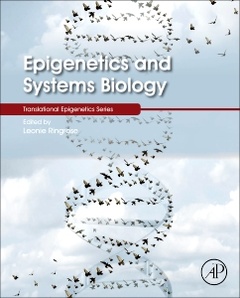Epigenetics and Systems Biology
Auteur : Ringrose Leonie

Epigenetics and Systems Biology highlights the need for collaboration between experiments and theoretical modeling that is required for successful application of systems biology in epigenetics studies.
This book breaks down the obstacles which exist between systems biology and epigenetics researchers due to information barriers and segmented research, giving real-life examples of successful combinations of systems biology and epigenetics experiments.
Each section covers one type of modeling and one set of epigenetic questions on which said models have been successfully applied. In addition, the book highlights how modeling and systems biology relate to studies of RNA, DNA, and genome instability, mechanisms of DNA damage signaling and repair, and the effect of the environment on genome stability.
Section I. Introduction
Section II: Where Am I? Genomic Features and DNA Sequence Principles Defining Sites of Epigenetic Regulation: Machine Learning1. Computational Identification of Polycomb/Trithorax Response Elements2. Modeling Chromatin States3. Crossing Borders: Modeling Approaches to Understand Chromatin Domains and Their Boundaries4. Inferring Chromatin Signaling From Genome-Wide ChIP-seq Data
Section III. Everything’s Moving: In Vivo Dynamics of Epigenetic Regulators: Kinetic Models Based on Ordinary Differential Equations5. “In Vivo Biochemistry: Absolute Quantification and Kinetic Modeling Applied to Polycomb and Trithorax Regulation6. Modeling Distributive Histone Modification by Dot1 Methyltransferases: From Mechanism to Biological Insights
Section IV: Reconciling Randomness and Precision: Bistable Epigenetic Memory and Switching: Stochastic Models7. Modeling Bistable Chromatin States8. Quantitative Environmentally Triggered Switching Between Stable Epigenetic States
Section V: The Third and Fourth Dimensions: Chromosomal Long Range Interactions: Polymer Models9. On the Nature of Chromatin 3D Organization: Lessons From Modeling10. From Chromosome Conformation Capture to Polymer Physics and Back: Investigating the Three-Dimensional Structure of Chromatin Within Topological Associating Domains11. A Combination Approach Based on Live-Cell Imaging and Computational Modeling to Further Our Understanding of Chromatin, Epigenetics, and the Genome12. Capturing Chromosome Structural Properties From Their Spatial and Temporal Fluctuations
- Presents original research in a wider perspective to reveal potential for synergies between the two fields of study
- Provides the latest experiments in primary literature for the modeling audience
- Includes chapters written by experts in systems biology and epigenetics who have vast experience studying clinical applications
Date de parution : 04-2017
Ouvrage de 286 p.
19x23.3 cm
Mots-clés :
Arabidopsis thaliana; Bistability; ChIP; ChIP-seq; Chromatin; Chromatin classification; Chromatin interactions; Chromatin modifier; Chromatin signaling; Chromatin structure; Chromatin/DNA labeling; Chromosome biophysics; Chromosome compaction; Chromosome conformation capture; Chromosome conformation capture (3C); Chromosome flexibility; Chromosome organization; Chromosome structure; Chromosome/DNA dynamics; Classifier performance; Computer simulations; Cooperativity; CpG; DNA; DNA methylation; Demethylase; Distributive; Domain boundary; Dot1; Drosophila; Dynamical systems; E-value; Epigenetic memory; Epigenetics; Euchromatin; Flowering Locus C; Fluorescence correlation spectroscopy; Fluorescence in situ hybridization; Fluorescence recovery after photobleaching; Gene regulation; Genome organization; Genome wide; H3K76; H3K79; Heterochromatin; Hi-C; Hidden Markov models; High-throughput 3D imaging; Histone methylation; Histone modification; Integrative modeling; Kinetic modeling; Live cell imaging; Live imaging; Local-global; Machine learning; Mathematical modeling; Methylomes; Methyltransferase; Microscopy; Modeling; Monte Carlo simulation; Motifs; Network reconstruction; Nuclear compartment; Nucleosome; Ordinary differential equations; PRE; Partial correlation; Polycomb; Polycomb response element; Polymer physics; Positive feedback; Processive; Profiling; Quantitative epigenetics; Simulation; Single molecule tracking; Single-nucleosome imaging; Stochastic simulation; Super-resolution imaging; Switch; TAD; Temperature-sensing; Training; Transcriptional regulation; Trithorax; Unsupervised learning; Vernalization; Yeast genome



